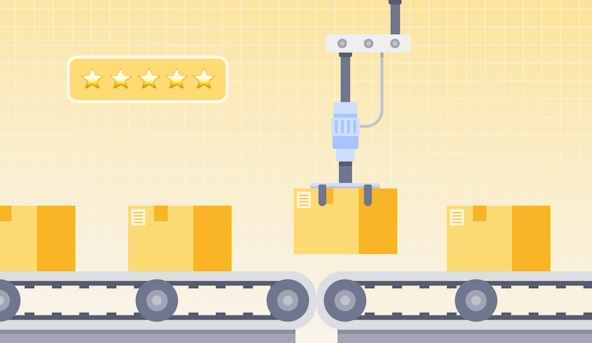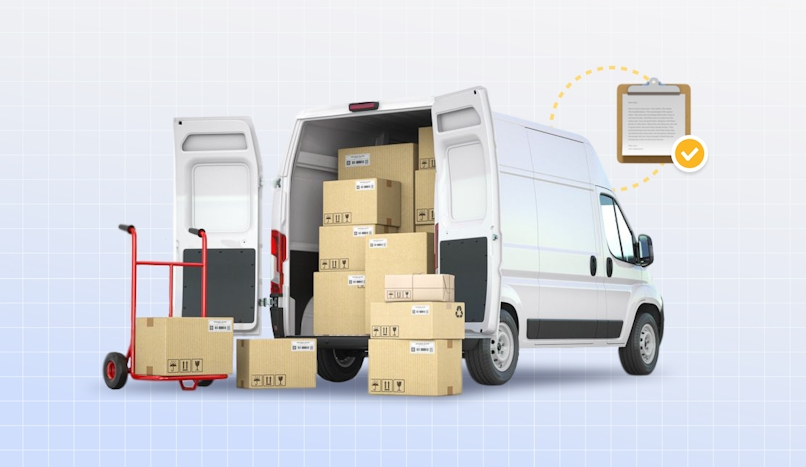What Is Material Handling and How Do You Optimize It?
Material handling is how goods are moved, stored, and protected throughout the supply chain. Discover how better material handling can help your business.

As a logistics or shipping company, optimizing material handling can reduce the risk of lost or damaged packages. Circuit for Teams can help.
In the logistics and shipping fields, the last thing you want is for goods to get lost or show up damaged, impacting customer satisfaction.
Well-organized material handling helps protect your deliveries so they make it from your warehouse, store, or distribution center to their destination intact.
From the movement, storage, and protection of products throughout your supply chain life cycle, to manufacturing, warehousing, and distribution.
A great material handling process is crucial. If you’re not using one, now is the time to start.
In this blog post, I break down what material handling is, how it can help your business, and how to start implementing it.

What is material handling?
Never heard of it? Material handling happens at every stage of the supply chain and takes different forms using both human- and machine-driven processes.
It refers to the way that products and materials are moved, stored, and protected throughout the supply chain. Material handling can take different forms, relying on both human- and machine-driven processes.
Good material handling practices make sure that products are moved efficiently and safely through the supply chain, from the point of production to the customer’s hands.
Material handling best practices help reduce problems like product damage or loss, which cost valuable money.
Proper material handling also quickens movement through the supply chain, helping you get goods into customers’ hands sooner. Working on your material handling process can help improve your last-mile delivery, getting goods to customers even faster.
Material handling throughout the supply chain
Material handling is important at every stage of the supply chain. Here’s a quick overview of what material handling systems look like at various stages.
Manufacturing
Manufacturing refers to the phase in the supply chain when a product is made. In the manufacturing context, material handling could refer to the movement of finished products from the factory floor to storage. This could involve human handling and machines like forklifts or side loaders.
Transportation
A product needs to be distributed once it is manufactured. In the transport phase of the supply chain, the completed goods are sent from the manufacturing facility to a wholesaler, distributor, or warehouse facility.
It’s important to use care to prevent damage in the transport process, such as careful loading onto industrial trucks and protective packaging.
Storage
Products rarely go from a distribution center, wholesaler, or warehouse directly to customers. Typically, these goods are offloaded at the site, inventoried, and safely stored. Then, they’re kept secure until needed by a retailer or supplier.
Distribution
Finally, the products can leave storage and enter the distribution phase. This is where they reach the end consumer, like a retailer or customer. The goods are taken out of storage, packed in shippable unit loads (like pallets), and shipped to their final destination.
The last step in the distribution journey is last-mile delivery. This is the stretch when the product reaches the customer’s hands. Last-mile delivery can be the most expensive and time-consuming part of the supply chain. Why?
Instead of sending goods in bulk from point A to point B, the goods need to be sent from one point to many different customers — meaning many routes, drivers, and vehicles are needed. Good material handling at this stage can help cut confusion and operating costs.
Types of material handling

Material handling is a complex process that can involve both human- and machine-led processes. Keep reading to learn more about the two main types of material handling and how they complement one another.
Manual handling
Manual handling is driven by humans. It might involve workers pushing, pulling, lifting, lowering, and carrying goods. They may use tools, like dollies, hoppers, or bucket elevators, to help them.
Unfortunately, this creates the capacity for human error. People make mistakes, for example, by dropping packages.
People can also hurt themselves through their errors. For instance, a person can injure their back by lifting a heavy weight incorrectly.
Automated handling
Increasingly, material handling professionals are prioritizing automated handling. Instead of relying on people, automated handling uses machinery to maneuver goods.
Types of material handling equipment include conveyor systems, hand trucks, and automated storage and retrieval systems. Human intervention is still needed for some types of automated handling. For example, a traditional forklift truck needs a driver.
However, advanced automated handling uses technology like machine intelligence, motion sensors, and robotics to automate tasks fully. For example, a robotic arm can be used to move packages off a conveyor belt and onto a pallet truck, or an automatic guided vehicle can replace a human-driven vehicle.
Automated equipment handling has the benefit of reducing the risk of human error. It can also be more cost-efficient, eliminating the need to train workers.
How to optimize material handling

Optimizing material handling can help improve your overall business operations and reduce the risk of lost or damaged goods. Here are some actionable tips for optimizing your material handling.
Tip #1: Measure and assess current processes
The first step toward improving any process is figuring out where you currently stand. Start by assessing your current material handling processes.
For last-mile delivery, for example, this could include basic raw data like how many packages you move in a day, the number of drivers you need, and the time a driver takes to complete a route.
You also have to consider the materials and operations costs associated with moving packages (for example, from warehouse shelves to trucks) like utilities, fuel, and machinery expenses.
Once you have this data, it’s time to see where you can cut costs. Say you discover that your average driver currently needs eight hours to complete a standard route. How can you help them cut this time?
You might survey your drivers and discover that one point of waste is locating packages in an overcrowded truck. Coming up with a system to organize packages so they’re easier to find (like this Amazon driver did) can help.
Putting barcodes on packages and using scanners can also make it easier to locate packages quickly—another trick from Amazon.
Tip #2: Simplify and standardize
Complexity is usually the enemy of efficiency. This is true in material handling.
Ideally, you want to minimize the amount of movement needed when simplifying processes. This saves workers effort and time—it can even save space.
For example, if you move finished goods to a loading dock instead of storing them in a warehouse first, you can cut a whole step out of the process. Your workers only have to move goods from point A to point B, instead of moving them from point A to storage and then from storage to point B.
Cutting out these extra movements also saves time. Plus, you won’t have to pay for the storage space.
Updating the tools you use can also improve the management process. Investing in bulk material handling that allows for better control of materials in large amounts is one way to streamline processes and cut handling costs, for instance.
For example, bulk bags or pallets allow you to move multiple goods at once, instead of taking many trips back and forth to move them. Other examples of bulk material handling equipment include bucket elevators, conveyor belts, and storage silos.
Say you have 500 boxes to move. You have a pallet that only holds 250 boxes. When moving all your boxes from point A to point B, you have to make two trips. If you invest in a larger pallet that can hold 500 boxes, you only have to make one trip.
Tip #3: Analyze your storage layout
The material handling process isn’t just about material movement. Storage is also a major component (and can be a major financial drain due to the cost of storage space).
The storage of raw materials can get expensive, especially if you have materials that need special care. Hazardous goods need special safety precautions, while delicate goods may need to be housed in HVAC-controlled facilities.
Which can all be a drain on your bottom line.
Assess your storage layout to see if there’s a way to save space. For example, you might stack items more tightly on pallets or try a different type of storage equipment, like stackable bins.
Even a small step like moving shelving closer together can help. That said, make sure narrow aisles can still comfortably accommodate people and machines.
Amazon’s warehouses are a great example. The Fall River fulfillment center, one of the company’s largest, covers 1.3 million square feet of floor space and is 4/10 of a mile long. The aisles are purposefully spaced very narrow to allow for maximum storage capacity.
Tip #4: Implement ergonomics for team members
Consider ergonomics when simplifying and streamlining processes. Finding ways to minimize repetitive motions and reduce manual labor can generally improve safety and efficiency.
For example, if you have order pickers who need to reach down into big bins to grab orders, that’s a lot of wasted motion. Reconfiguring your storage space, as described above, can make it easier and faster to handle materials. Bulk handling equipment like conveyor belts can help in this instance.
The aim is to prioritize speedy work. This may mean creating a set up that doesn’t seem “logical.” Amazon’s warehouses are renowned for this trick.
The e-commerce giant doesn’t organize inventory according to category type, which might seem logical (like, putting all the personal hygiene products in one place). Instead, they prioritize efficiency by putting single types of inventory across multiple picking points in their warehouses.
So, if a product picker needs to find a cooking pot that a customer has ordered, they can find the nearest pickup point for that pot (using a barcode scanner). Ideally, there will be a pickup point nearby.
If all the pots were stored in one spot across the warehouse, the worker would have to waste a lot of time going to get it. The multiple pick-up point strategy saves workers hours and energy.
Tip #5: Automate when possible
Finally, make the most of the cutting-edge technology available to you. Automation is a great way to improve consistency and boost efficiency.
Automated machinery can reduce operational costs and improve the handling of goods. Automated material handling systems (AHMS) might be a more expensive investment upfront, but they can pay off in the long run.
As mentioned, automated handling tends to reduce the risk of human error, saving money by avoiding losses and damage. By increasing accuracy, automation can further improve efficiency and reduce waste.
Algorithms are one way that warehouse and logistics pros like Amazon are embracing automation. In an Amazon warehouse, humans still pack the boxes. But the size of each product’s packing box is predetermined by an algorithm.
A barcode reader recognizes the product and, based on its weight and dimensions, designates the appropriate packaging. The human worker doesn’t have to think about what box is needed or test out packaging options that might not fit.
Shipping materials? Discover how Circuit for Teams can help
Optimized material handling can help you move, store, and protect products throughout the supply chain. If you’re involved in the distribution stage of the supply chain — for example, as a delivery services provider — you can further improve your material handling with Circuit for Teams.
Circuit’s routing software helps you optimize your drivers’ routes, getting them from one stop to the next safely and quickly. Circuit also can improve your material handling.
For example, the package finder feature makes it easy for drivers to locate products in their trucks. There’s no need to rifle through an overstuffed delivery vehicle, potentially damaging packages in the process.
Circuit also offers a bunch of other features that can make your delivery drivers’ lives easier, like a proof-of-delivery function and delivery time window setting. All of this adds up to faster, more secure deliveries — saving your team time and stress and your company money.





